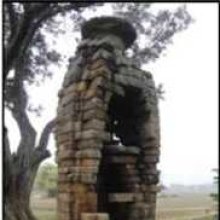Pancayatana, Pañcāyatana, Pamcayatana: 8 definitions
Introduction:
Pancayatana means something in Hinduism, Sanskrit, the history of ancient India, Marathi. If you want to know the exact meaning, history, etymology or English translation of this term then check out the descriptions on this page. Add your comment or reference to a book if you want to contribute to this summary article.
Alternative spellings of this word include Panchayatana.
Images (photo gallery)
In Hinduism
Purana and Itihasa (epic history)
Source: archive.org: Puranic EncyclopediaPañcāyatana (पञ्चायतन).—An idol of Śiva in Kāśī. This idol is called Oṃkāra also. Bhagavān Parameśvara who gives mokṣa to men dwells in this idol in the form of Pañcāyatana. The five souls of Śiva are the five āyatanas. They are Śānti (tranquillity), Atītaśānti (passed beyond tranquillity), Parāparavidyā (Greater and smaller knowledge), Pratiṣṭhā (celebrity) and Nivṛtti (Recession). Because these five āyatanas dwell in the idol of Śiva at Kāśī it got the name Pañcāyatana. (Chapter 34, Padma Purāṇa).
Source: Cologne Digital Sanskrit Dictionaries: The Purana IndexPañcāyatana (पञ्चायतन).—A sacred place on the Narmadā.*
- * Matsya-purāṇa 191. 6.

The Purana (पुराण, purāṇas) refers to Sanskrit literature preserving ancient India’s vast cultural history, including historical legends, religious ceremonies, various arts and sciences. The eighteen mahapuranas total over 400,000 shlokas (metrical couplets) and date to at least several centuries BCE.
Ganapatya (worship of Ganesha)
Source: Google Books: Ganapati: Song of the SelfPañcāyatana (पञ्चायतन) or Pañcāyatanapūjā refers to the “worship of five forms”, which was popularized by Śaṅkarācārya, invokes the five deities Gaṇapati, Viṣṇu, Śiva, Devī, and Sūrya. It was instigated primarily to unite the five principal deities of the five major sects (Gāṇapatyas, Śaivas, Vaiṣṇavas, Śāktas, and Sauras) on an equal status, and, coincidentally, it takes into account the five physical elements. Gaṇeśa represents the element water, Viṣṇu represents space, Śiva represents earth, Devī represents fire, and Sūrya represents air.
Ganapatya (गाणपत्य, gāṇapatya) represents a tradition of Hinduism where Ganesha is revered and worshipped as the prime deity (ishta-devata). Being a minor though influential movement, Ganapatya evovled, llike Shaktism and Shaivism, as a separate movement leaving behind a large body of literature.
India history and geography
Source: Cologne Digital Sanskrit Dictionaries: Indian Epigraphical GlossaryPañca-ayatana.—(EI 28; CII 4), a type of temple ‘consisting of five rooms’; a five-shrine temple. Note: pañca-ayatana is defined in the “Indian epigraphical glossary” as it can be found on ancient inscriptions commonly written in Sanskrit, Prakrit or Dravidian languages.

The history of India traces the identification of countries, villages, towns and other regions of India, as well as mythology, zoology, royal dynasties, rulers, tribes, local festivities and traditions and regional languages. Ancient India enjoyed religious freedom and encourages the path of Dharma, a concept common to Buddhism, Hinduism, and Jainism.
Languages of India and abroad
Marathi-English dictionary
Source: DDSA: The Molesworth Marathi and English Dictionarypañcāyatana (पंचायतन).—n (S) The five deities, viz. śiva, viṣṇu, sūrya, gaṇapati, dēvī; and fig. a club or knot of five persons, a cabal.
Source: DDSA: The Aryabhusan school dictionary, Marathi-Englishpañcāyatana (पंचायतन).—n The five deities, viz., śiva, viṣṇu, sūrya, gaṇapati, dēvī. A club or knot of five persons, a cabal.
Marathi is an Indo-European language having over 70 million native speakers people in (predominantly) Maharashtra India. Marathi, like many other Indo-Aryan languages, evolved from early forms of Prakrit, which itself is a subset of Sanskrit, one of the most ancient languages of the world.
Sanskrit dictionary
Source: Cologne Digital Sanskrit Dictionaries: Monier-Williams Sanskrit-English DictionaryPañcāyatana (पञ्चायतन):—[from pañca] n. Name of a [particular] ceremony (at which 5 symbols are used), [Religious Thought and Life in India 410-416]
Sanskrit, also spelled संस्कृतम् (saṃskṛtam), is an ancient language of India commonly seen as the grandmother of the Indo-European language family (even English!). Closely allied with Prakrit and Pali, Sanskrit is more exhaustive in both grammar and terms and has the most extensive collection of literature in the world, greatly surpassing its sister-languages Greek and Latin.
Kannada-English dictionary
Source: Alar: Kannada-English corpusPaṃcāyatana (ಪಂಚಾಯತನ):—[noun] (pl.) the five gods Śiva, Pārvati, Viṣṇu, the Sun, and Gaṇapati, worshipped daily by Smārta Brāhmaṇas.
Kannada is a Dravidian language (as opposed to the Indo-European language family) mainly spoken in the southwestern region of India.
See also (Relevant definitions)
Partial matches: Ayatana, Panca.
Starts with: Pancayatanapaddhati, Pancayatanapratishthapaddhati, Pancayatanapuja, Pancayatanarthavarnashirshopanishad, Pancayatanatharvanashirsha, Pancayatanatharvanashirshopanishad.
Ends with: Shivapancayatana.
Full-text: Shivapancayatana, Pancayatanapaddhati, Pancayatanapratishthapaddhati, Suryadipancayatanapratishthapaddhati, Pancayatanarthavarnashirshopanishad, Ghantamudra, Pancayatanapuja, Devapratishtha, Surya, Dhyana.
Relevant text
Search found 13 books and stories containing Pancayatana, Pamcayatana, Paṃcāyatana, Panca-ayatana, Pañca-ayatana, Pañcāyatana, Pancāyatana; (plurals include: Pancayatanas, Pamcayatanas, Paṃcāyatanas, ayatanas, Pañcāyatanas, Pancāyatanas). You can also click to the full overview containing English textual excerpts. Below are direct links for the most relevant articles:
Patthana Dhamma (by Htoo Naing)
Chapter 25 - Atthi paccayo (or presence condition)
Chapter 27 - Avigata paccayo (or non-disappearance condition)
Puranic encyclopaedia (by Vettam Mani)
The Padma Purana (by N.A. Deshpande)
Chapter 34 - The Greatness of Kṛttivāseśvara < [Section 3 - Svarga-khaṇḍa (section on the heavens)]
The Skanda Purana (by G. V. Tagare)
Chapter 260 - Paijavana Takes Leave < [Section 1 - Tīrtha-māhātmya]
Chapter 238 - Importance of Penance < [Section 1 - Tīrtha-māhātmya]
Chapter 11 - The Previous Births of the Tortoise < [Section 2 - Kaumārikā-khaṇḍa]
Vastu-shastra (5): Temple Architecture (by D. N. Shukla)
Chapter 6 - Group C: Nāgara Prāsādas
Temple architecture in Cambodia < [Chapter 12 - History of Hindu Temples (Prāsādas and Vimānas)]
Samarangana-sutradhara (Summary) (by D. N. Shukla)


